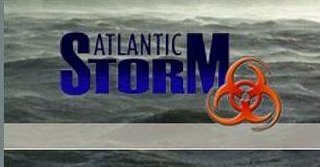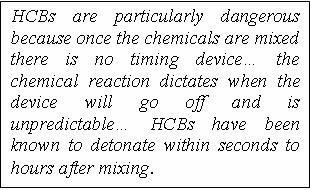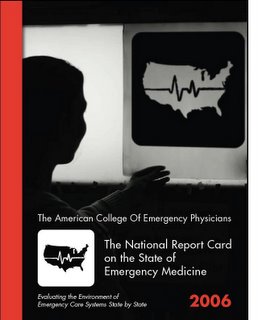The FBI conducted tests, involving
a 7-ounce mixture of potassium chlorate, sulfur, sugar, and baby powder, demonstrated the bottle bombs could be exploded in a car or plane. The FBI stated that the explosion could tear apart nearby passenger seats and puncture a plane’s fuselage. One FBI agent testified that such a bomb
“would likely cause significant damage to the aircraft and cause injury or death to the persons on board.” He said it also could
“cause catastrophic failure” of a pressurized aircraft if exploded at high altitude.
Although the possibility of facing a terrorist attack aboard a commercial airliner is remote for most emergency responders;
the possibility of a “household chemical bomb” scenario may not be as low as one would assume. The “All-Hazards Approach” to emergency response demands that firefighters and emergency medical technicians understand the lethality of common chemicals that can be turned into Homemade Chemical Bombs or HCBs.
Discussion:
Homemade Chemical Bombs (HCBs) are easily constructed out of every-day materials and chemicals. The internet is loaded with video clips and instructions for such activity. HCBs are also known as MacGyver bombs, bottle bombs, “the works” bomb or acid bombs, are explosive devices created by mixing volatile household chemicals, usually in some type of pressure vessel. Toilet bowl cleaner or drain cleaner and tin foil mixed in a capped soda pop bottle are among the most common, and perhaps the most toxic, combination of materials. The mixture of isopropyl alcohol and chlorine or dry-ice and warm water and mixed in a capped water bottle yield a similar result. Regardless of the combination, the products are mixed together and placed in a soda pop bottle or other container suitable to containing pressure. The container eventually ruptures violently resulting in overpressure, fragmentation, shrapnel, and often times hazardous materials.
Indicators:
Callers to 9-1-1 reporting HCB events often report an “explosion”, “fireworks”, or “shot gun fire”. Surveillance data from various sources provide a fairly descriptive profile for HCBs. The chemicals most often used are sodium hypochlorite, sodium hydroxide, and hydrochloric acid. A majority of events occur on school property; such as local schools, college or university settings. HCB events have been reported in public places and residential areas. A majority of events occur during the summer or during after-school hours. There is however, no formal data base for this type of activity and numerous events may go unreported or unrecognized.
HCBs are particularly dangerous because once the chemicals are mixed there is no timing device… the chemical reaction dictates when the device will go off and is unpredictable… HCBs have been known to detonate within seconds to hours after mixing.HCBs can be constructed using a variety of chemical mixes and any container capable of allowing pressure build-up. Common containers are plastic soda pop bottles, sports drink bottles, and water bottles of all sizes. These containers have a screw-on cap and expand to allow for containment of greater pressure prior to detonation. The liquid inside the container may be green, bluish, or clear, depending on the chemical and may have tin foil rolled into balls or folded into strips inside the liquid. Regardless of the type of material; the liquid may be fuming as the chemical reaction takes place.
As the reaction progresses the container will begin to bulge or expand. Due to the variable amount of chemicals, each HCB should be considered unique and unpredictable. Containers that are bulging should be considered volatile and may detonate at anytime. It is possible that a pressure within a container will build-up to the point of expansion, yet not rupture. Any movement of a container in this condition may cause it to detonate.
Containers may be wrapped with nails or placed inside of a garbage can to produce shrapnel and fragmentation. Responders should be alert for bulging discarded containers.
Once a HCB has detonated, the residue varies with the chemicals used. The use of cleaning solutions and tin foil usually produces a foaming blue or green liquid (depending on the manufacturer of the cleaning product). HCBs made with alcohol and chlorine may leave only the smell and a cloud of the product. Dry-ice and water will totally disintegrate. In either case, the remains of the container may be the only indicator or evidence a HCB has gone off.
Injury Patterns:
Assuming that the HCB is a simple act of vandalism is a serious mistake.
These devices meet both the National Fire Academy (NFA) and National Fire Protection Association (NFPA) definition of an explosive device. All of the chemical combinations used for HCBs are capable of causing deflagration and result in an overpressure situation. Although unlikely to cause serious structural damage or fire, HCB situations may result in primary and secondary blast injuries. Primary blast injuries result directly from the sudden overpressure changes caused by the blast. This overpressure is most likely to effect hollow structures such as the lungs, gut, and ears. HCB events often occur in open areas resulting in limited overpressure; rupture of the ear drums may be the most common of the primary injuries. It is important to remember that overpressure events are magnified by confined or enclosed spaces and an HCB detonated in confined areas should make one suspicious for other primary overpressure injuries. Responders should be aware that as little as 1.0 - 5.0 psi overpressure is sufficient to break windows and rupture tympanic membranes.
Secondary blast injuries are those injuries resulting from flying debris or shrapnel. HCBs are capable of scattering shrapnel and producing secondary injury. Mechanical and thermal injury

may also result from the device going off as it is picked up by a responder or civilian. Keep in mind the person making the bomb may become an unintended victim.
HCBs are particularly dangerous because once the chemicals are mixed there is no timing device. The lack of fuses or timers means the chemical reaction dictates when the device will go off and is unpredictable. HCBs have been known to detonate within seconds to hours after mixing. Sodium hypochlorite is a frequently used chemical in making an HCB; however, other hazardous materials (ammonia, liquid nitrogen, and dry ice) may also be used (CDC unpublished data, 2003). Low to medium exposure to sodium hypochlorite, as found in household bleach, can cause irritation of the eyes, skin, and respiratory system. High levels can result in severe corrosive damage to the eyes, skin, and respiratory system and may be fatal. Exposure to other HCB products, such as hydrochloric acid can cause mucous membrane irritation laryngeal spasm and pulmonary edema.
Patient care should be dictated by injury severity, signs and symptoms, and local hazardous materials protocol. Responders should be anticipating the possibility of numerous patients, and thus be ready to undertake triage actions. There may also be need for gross decontamination at the scene prior to transport of any patient. Persons exposed the products of HCBs may also self-refer to local hospitals. Hospitals should be alerted whenever a HCB event is discovered in effort to prevent self-referring patients from contaminating the emergency department. Fire departments should be prepared to respond to local emergency departments in anticipation of decontaminating self-referring patients. Decontamination of patients prior to transport and prior to entering the emergency department is vital to preventing secondary contamination of the hospital. This role should be assigned to fire service personnel with training in decontamination or hazardous materials teams.
Summary:Homemade chemical bombs (HCBs), also known as acid bombs, MacGyver bombs, bottle bombs, or “the works” bombs, are capable of creating chemical, thermal, and mechanical injuries. HCBs are unpredictable and may go off within minutes to hours after mixing. When deployed in public places, HCBs may create multiple patient – hazardous materials events resulting in the need for mass casualty gross decontamination both at the scene, and at the hospital. Patients must undergo decontamination prior to transport, but exposed persons may leave the scene prior to arrival of fire or EMS units. Fire departments must be ready to deploy to local emergency departments anticipating self-referring exposed individuals and preventing secondary contamination of the emergency department.
In addition to suitable personal protection, responders must be ready for hazardous materials and cautious of secondary events.
Underestimating HCBs as an act of vandalism can be deadly. These devices are capable of spreading shrapnel and fragmentation; turning a soda pop or water bottle into a deadly device. The unpredictable nature of HCBs, relative ease of construction, and combination of hazardous materials makes homemade chemical bomb events a true threat to responders and a challenge to successful patient care.
Implementing the All-Hazards Approach to training, pre-planning, and incident management will assist traditional response agencies with identification and successful mitigation of this type of event.
Selected Case Studies:Rhode Island, May 2000. Two students were making bottle bombs on an elementary school playground using hydrochloric acid. The two students sustained eye irritation from the detonation of one of the bombs. Both were transported to a hospital for treatment and released. The school was evacuated for one-hour while a hazardous materials team conducted decontamination and debris removal.
Rhode Island, October 2001. A high school student placed a chemical bomb in a vacant classroom. The bomb, made with sodium hypochlorite, released chlorine gas on explosion. A total of twenty-three persons in the vicinity of the explosion sustained respiratory irritation and were transported to a hospital for treatment and released. The school was evacuated, and a HazMat team conducted decontamination and debris removal.
New York, June 2002. A sixteen-year-old sustained chemical burns after detonating a bottle bomb made from sodium hypochlorite in a friend’s front yard. The juvenile was transported to a hospital for treatment and released.
Rochester, NY, April 2004. Several persons, including emergency responders were contaminated with by-product acid as an acid bomb detonated while a suspect was being taken into custody.
References:1. Agency for Toxic and Disease Registry, Hazardous Substances Emergency Events Surveillance System biennial report, 1999-2000. Atlanta, Georgia: U.S. Department of Health and Human Services, Agency for Toxic Substances and Disease Registry, 2001.
http://www.atsdr.cdc.gov/HS/HSEES2. CDC NIOSH, U.S. Department of Health and Human Services, CDC, 1997.
http://www.cdc.gov/niosh/npg/npg.html3. New Jersery Department of Community Affairs, Division of Fire Safety. Bottle Bombs, Trenton, New Jersey, 2003.
http://www.state.nj.us/dca/dfs/bombs.htm4. R. Russotti. Blast, Crush and Overpressure Injuries, April, 2003.
rrussotti@frontiernet.net,
http://mitigationjournal.blogspot.com/Keywords:
1. Bottle Bomb
2. Baby Bottle Bomb
3. MacGyver Bomb
4. Acid Bomb
5. “The Works” Bomb
6. Homemade Chemical Bomb









